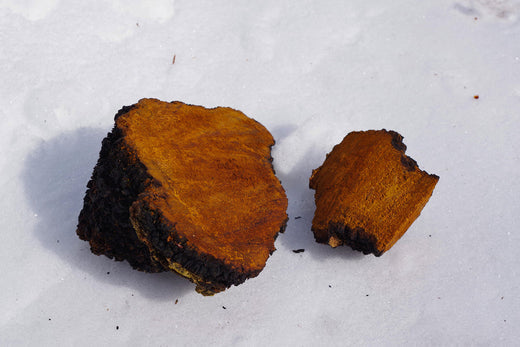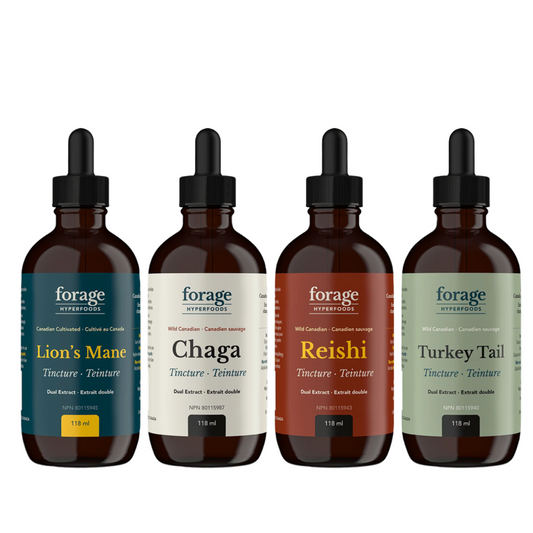
When Should Chaga Be Harvested?
Share
There’s a common misconception about when Chaga should be harvested. Does it favour warm or colder temperatures? And why? With so much misinformation swirling around the web, we thought we’d offer some clarity around this debate. Before we dive into the nitty-gritty of when to harvest Chaga, let’s briefly go over some basics.
What is Chaga?
Although it’s typically referred to as a mushroom, Chaga (Inonotus obliquus) is actually a sclerotia—a hardened mass of fungal mycelium. A parasitic fungus, Chaga primarily grows on birch trees in cold climates, like those in Canada, Siberia, Scandinavia, and some parts of the United States.
Chaga doesn’t pop up from the forest floor like most mushrooms. Rather, Chaga appears on birch trees as a black, charcoal-like mass (called a conk) with a woody, orange interior. Use this guide to learn how to identify Chaga mushroom in nature. Despite its unsightly exterior, the wide-ranging health benefits of Chaga more than make up for its lack of aesthetic beauty. Chaga is packed with antioxidants, vitamins, and minerals, making it a functional fungi powerhouse! It has been shown to support a strong immune system, provide anti-inflammatory benefits, support heart health, promote good digestion, and potentially play a role in cancer prevention, just to name a few. You can learn more about its benefits in more detail here. One interesting theory is that Chaga’s many beneficial compounds may be a result of natural adaptations by the fungus to withstand the cold, harsh climate in which it grows.
Alright, now that you’re better acquainted with the “king of medicinal mushrooms,” let’s learn about the best time to harvest it.
When is the best time to harvest Chaga?
Good news: Chaga can be harvested year-round! There are several recommendations online that it should only be done when the temperature is below 41°F, but research doesn’t really support that claim. Seasoned Chaga harvesters note virtually no difference in the Chaga's chemical and medicinal composition between seasons.
Pros and cons of harvesting Chaga in different seasons
While the time of year doesn’t much affect the quality of the Chaga itself, the ease, experience and expense can vary seasonally. Let’s get into the pros and cons of harvesting by season.
In winter, the dark, charcoal-like Chaga conks, can be very easily spotted against the white of the snowy forest. On the other hand, freezing temperatures can make harvesting both uncomfortable and challenging, as frozen conks are considerably more difficult to remove from their host trees.
Harvesting in the dry summer months comes with the advantage of finding dry Chaga. By contrast, Chaga harvested in wet seasons has absorbed moisture, increasing the processing time needed to dry and prepare the Chaga for consumption. That said, movement and visibility through the forest when the canopy’s foliage is full can be more difficult than in the winter.
Ultimately, which season you choose to harvest Chaga really comes down to personal preference.
How to harvest Chaga
While the time of year isn’t important when it comes to harvesting Chaga, it is important to know how to find a Chaga conk that is suitable for harvesting.
First of all, it’s important to find Chaga that is away from pollution. Because Chaga can take up to 20 years to reach full maturity, it has years to soak up all the pollutants from its surrounding environment. That’s why you should not harvest Chaga that is close to roads, cities, factories, railroads, farms, or any other area with poor air quality.
Secondly, make sure that the Chaga you wish to harvest is growing on a living tree. Chaga is a parasitic fungus, so when the host tree dies, the Chaga dies, too. In non-winter seasons, you can be sure a tree is alive if it has leaves. In the winter, you can look for winter buds. On a dead host tree, there are generally no leaves or winter buds and the branches will be rotted. It will likely be soft as well, so give it a knock to test it out.
Lastly, find a Chaga mushroom that is at least the size of a grapefruit—the bigger the better! The larger a conk grows, the more time it has to extract and store nutrients from the tree, making the bigger mushrooms more nutrient-dense.
Once you’ve found Chaga that meets the three above-mentioned criteria, you can remove it by cutting it with a knife, chopping with an ax, or prying it off with a stick. Now, this is the most important point: be sure to leave at least 20-30% of the Chaga intact on the tree. This will allow the Chaga to grow back for others to harvest and enjoy. Be sure to harvest with great care so that you don’t damage the host tree, as this can leave the tree susceptible to infections.
Find a trusted source for your Chaga
Purchasing Chaga mushroom from a trusted supplier is the best way to ensure its effectiveness and safety. Not all Chaga products are created equal so be sure you’re getting yours from a company whose Chaga is organically grown, sustainably harvested, carefully extracted, and tested for quality and contaminants, such as heavy metals, pesticides, microbial contamination, and gluten. If a Chaga supplement lists any ingredients like “mycelium on grain” or other funky fillers, avoid it. To reap the full potential of this fungal powerhouse, seek a Chaga extract that uses wild-harvested Chaga.
The takeaway
As you’ve learned today, ignore anyone who says Chaga can only be harvested at certain times of the year. The chemical composition of Chaga does not change with the seasons. When a person harvests Chaga truly depends on what works best for them.



